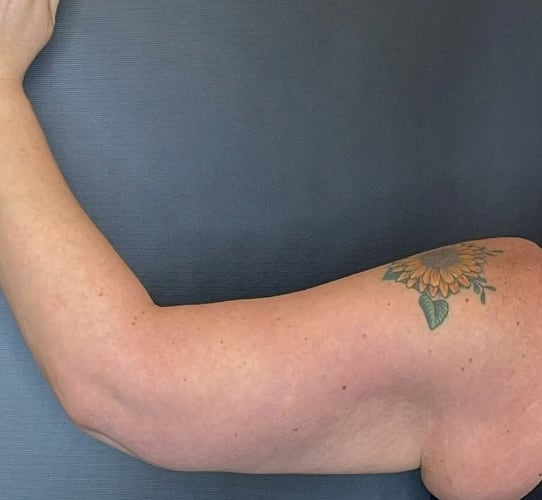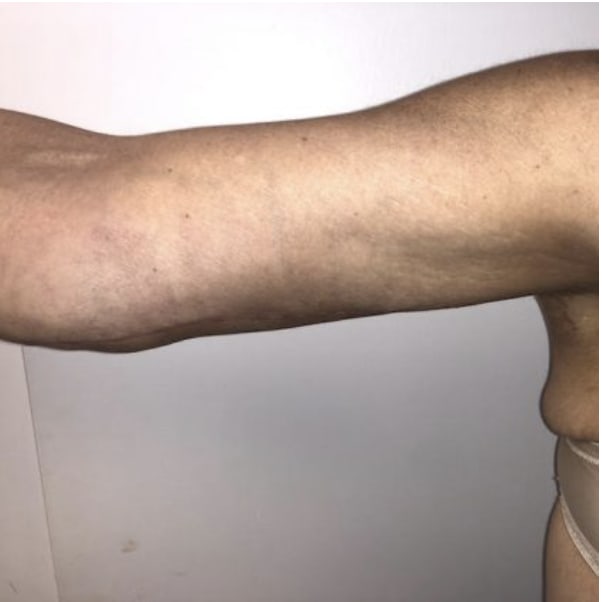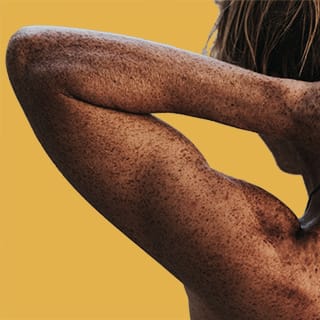
The Skinny
Overview
With age or considerable weight loss, many people develop excess fat and sagging skin on their upper arms. This causes the triceps area of the arms to droop; a condition commonly referred to as “bat wings”. An arm lift procedure is an aesthetic plastic surgery that removes the extra skin and fat tissue, thereby helping to create new contours and enhance the patient’s body image and self-confidence.
This page reviews the goal of arm lift surgery, risks and possible side effects, steps involved in the procedure, and some before and aftercare tips. It also lists some pros and cons of the surgery, addresses who make good candidates for an arm lift and looks at who it is not typically recommended for.
AEDIT
Before & After Images by Provider












Before & After Images by Provider
Arm Lift (Brachioplasty) Solutions
The Specifics
Goals for Arm Lift Surgery
The technical term for an upper arm lift procedure is “brachioplasty”. It is a body contouring surgical technique used to modify the appearance of the underside of the upper arm from the armpit to the elbow. The goal of brachioplasty is to remove excess fat, tighten loose skin, and thereby reshape the arm to create a more youthful, toned appearance.
Pros/Cons of the Procedure
According to the American Society of Plastic Surgeons, some of the key benefits of an arm lift procedure are:
Removes extra skin and tightens loose skin to enhance the appearance of drooping upper arms
The main “con” of this surgery is that it does produce some permanent scarring. Many patients require the removal of excess skin and therefore must have incisions that run from the armpit to the elbow. However, in less severe cases, upper arm skin tissue excision is not necessary and only a small incision by the elbow is needed to accommodate liposuction.
Remember, each patient is unique and requires a custom-designed treatment plan. A board-certified plastic surgeon can advise you about the incision patterns that you would need.
Ideal Candidates
Thousands of men and women have arm lift surgeries performed in the United States every year. Many of them have worked diligently to lose significant amounts of weight and then, find that the stretched skin on their upper arms, thighs, waist, faces, and breasts is sagging.
Other brachioplasty patients request this body contouring surgery because they want to tighten up the loose skin that results from the natural aging process. With age, most people develop lower levels of important proteins that support connective tissues and promote skin elasticity, like collagen and elastin, for example.
In general, you are likely a good candidate for an arm lift if you:
The best way to determine your candidacy for an arm lift surgery is to schedule a consultation appointment with a board-certified plastic surgeon who specializes in brachioplasty. You can address all of your questions and concerns during this appointment and learn about how the surgeon makes you feel on a personal level. It is very important to have a pleasant and trusting rapport with your doctor.
Not Recommended For & Contraindications
Although brachioplasty is generally safe for most people, your surgeon may advise against it if you have a medical condition that would inhibit your ability to heal from invasive surgery. An arm lift procedure may also not be recommended if you are significantly overweight, experience repetitive weight fluctuations, smoke or use tobacco products, or have unrealistic goals for the surgery,
Addressing these and other patient-specific issues beforehand create a safer route for the procedure and allow for optimal surgical results.
Risks and Side Effects
As it is with any major surgery, there are risks associated with the arm lift process, including those linked to the use of general anesthesia. Some possible adverse effects that can occur during or after this procedure include:
According to research from Vanderbilt University, seroma and infection are the two most common side effects of arm lift surgery. Being male or having a body mass index (BMI) of 30 or more increases your risks for arm lift side effects.
Be sure to address any concerns or questions about your safety during an arm lift before committing. Contact your surgeon right away if you experience chest pain, irregular heartbeat, fever, or shortness of breath after you return home from your surgery.
Steps of the Procedure
The steps of brachioplasty vary based on the specific goals for individual patients. However, in general, the procedure progresses as follows:
Arm lift surgery produces immediate and significant results. It is a generally safe and effective treatment for loose, sagging upper arms in both men and women.
Before and Aftercare
When you are preparing for an arm lift, your cosmetic surgeon may ask you to: stop smoking, stop using blood thinners, have certain laboratory tests performed, and either begin using certain medications or stop using others.
Remember to arrange transportation to and from the surgical center or hospital where your surgery is scheduled. It is also advised to have a friend stay with, monitor, and help care for you for at least the first night after the procedure.
You will see your doctor for a checkup after surgery, typically within 48 hours. If you have traditional stitches, they will be removed within 1-2 weeks. Patients will return for follow-up visits as needed to ensure proper healing with no complications.
Your surgeon will likely instruct you to avoid showering for the first 48 hours, avoid raising your arms above your head for 2-4 weeks and avoid other activities that could stretch and tear your incisions for 4-8 weeks
You will be prescribed pain medications, antibiotics, and anti-inflammatory drugs as needed to help you manage your pain and accommodate healing after the surgery.
The Takeaway
Conclusion
Sometimes exercise and diet are not enough to get rid of the excess skin and fat that causes the undersides of the upper arms to sag. Millions of people face this concern and brachioplasty offers a safe and effective treatment for many of them.
Before deciding to have this body contouring surgery, take your time learning about it and developing a thorough understanding of what the procedure entails, the possible adverse effects that sometimes result, and realistic expectations for the overall results.
The American Society for Aesthetic Plastic Surgery reports that brachioplasty has a 93.4% patient satisfaction rate. Most people who have this surgery say that they believe the scarring is made up for by the more favorable aesthetic results they achieve. If you believe arm lift surgery may be for you, then schedule an initial consultation with a board-certified cosmetic surgeon to discuss your questions and concerns.

